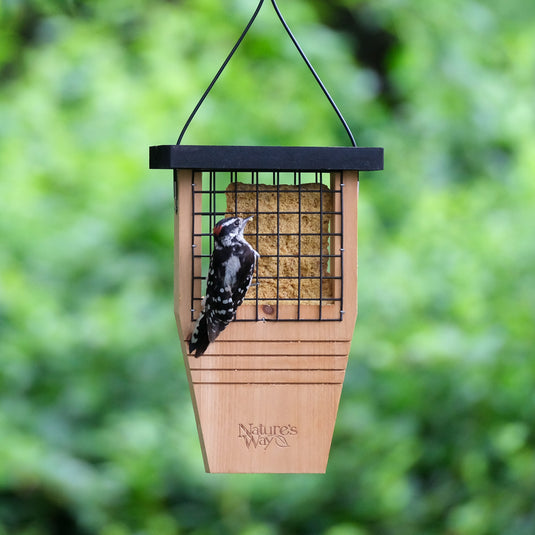Have you ever wondered how to attract more birds to your backyard, especially during colder months? A suet bird feeder might be the simple solution you need.
This special feeder offers a tasty treat that many birds love, helping you enjoy more colorful and lively visitors all year round. You’ll discover exactly what a suet bird feeder is, why it’s great for your feathered friends, and how it can transform your bird-watching experience.
Keep reading to learn how this small addition can make a big difference in your outdoor space.
Types Of Suet Bird Feeders
Cage feedersare simple wire cages that hold blocks of suet. Birds cling to the cage and peck at the suet through the openings. These feeders keep suet safe from larger animals and allow multiple birds to feed at once.
Hopper feedershave a covered container that holds suet inside. Birds perch on small ledges and eat from openings. These feeders protect suet from rain and keep it fresh longer.
Tray feedersoffer a flat surface to place suet cakes or balls. Birds can easily land and feed. These feeders are easy to clean but offer less protection from weather and squirrels.

Credit: www.wildbirdsuets.com
Choosing The Right Suet
A suet bird feeder holds blocks of suet, a fatty food loved by many wild birds. It attracts woodpeckers, nuthatches, and other insect-eating birds during colder months. Choosing the right feeder helps keep suet fresh and birds safe.
Ingredients To Look For
Suet should contain natural fatslike beef fat or vegetable oil. Seeds such as sunflower, millet, and cracked corn attract many birds. Look for suet with no artificial colors or preservatives. Adding nuts and dried fruits boosts energy for birds. Avoid suet with chemicals or fillers that may harm birds. High-quality ingredients keep birds healthy and active.
Seasonal Suet Options
In winter, use suet rich in fat and caloriesto help birds stay warm. Summer suet blends often have less fat and include fruits and insectsfor extra protein. Different seasons need different foods to support bird health. Changing suet with seasons keeps birds happy and coming back.
Placing Your Suet Feeder
A suet bird feeder holds blocks of suet, a high-energy food for birds. Placing it near trees or shrubs helps birds feel safe while feeding. Choose a spot visible from your window to enjoy birdwatching easily.
Ideal Locations
Suet feeders are best placed in quiet spots. Choose a location away from busy areas. Birds prefer peaceful places to feed. Hang the feeder near trees or bushes. This provides natural cover for birds. It also helps them feel safe. Avoid windy spots. Wind can make it hard for birds to balance. Sheltered areas are ideal for suet feeders.
Avoiding Predators
Keep feeders out of reach of cats. Hang them high enough to prevent access. Use poles or hanging devices. Distance feeders from fences. This reduces the risk of predators. Choose spots where birds can see danger coming. Open areas can help birds escape quickly. Safety is important for bird feeding.

Credit: www.kingsyard.com
Attracting Different Bird Species
Suet bird feedersattract many types of birds. They offer a high-energy food source, especially in cold weather.
Woodpeckerslove suet because it is easy to cling to while they peck. They find it a great source of fat and protein.
Nuthatchesenjoy suet feeders too. These birds often hang upside down to eat, showing their agility.
Titmice and chickadeesare small birds that visit suet feeders often. They benefit from the energy packed in suet, especially in winter.
- Woodpeckers: cling while pecking, love fat and protein
- Nuthatches: hang upside down, agile feeders
- Titmice and Chickadees: small, high-energy food lovers
Maintaining Your Suet Feeder
Keep your suet feeder clean to protect birds from disease. Wash it with warm, soapy water after every use. Rinse well to remove soap residue. Dry completely before refilling.
Prevent mold and spoilage by removing old suet regularly. Store extra suet in a cool, dry place. Avoid placing feeders in direct sunlight for long periods. This helps keep suet fresh longer.

Credit: www.natureswaybirds.com
Frequently Asked Questions
What Is A Suet Bird Feeder Used For?
A suet bird feeder holds suet cakes that attract insect-eating birds in winter.
How Do Suet Bird Feeders Benefit Wild Birds?
They provide high-energy food that helps birds stay warm and active in cold weather.
Which Birds Visit Suet Feeders Most Often?
Woodpeckers, nuthatches, chickadees, and wrens are common visitors to suet feeders.
Conclusion
A suet bird feeder attracts many wild birds to your yard. It offers energy-rich food that birds love, especially in cold weather. This feeder is easy to fill and clean, making birdwatching simple and fun. Watching birds enjoy suet can bring joy and peace to your day.
Try using a suet feeder to support local wildlife and enjoy nature close by. Small effort, big rewards.
